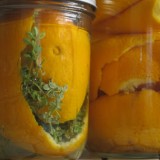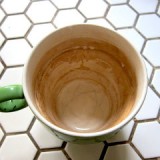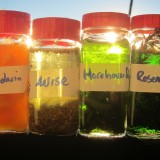
Tarnished flatware waiting for a bath
Here at Root Simple, we live high on the hog. We eat off of silver spoons every day. It’s true. I inherited a set of silver flatwear and utensils from my mom’s side of the family, and instead of saving them for Christmas and Thanksgiving, I use them every day.
This is fairly revolutionary, as I come from a family of Savers. Recently, I unearthed a set of six snowy white damask dinner napkins from the family treasury, painstakingly ironed into perfect squares, centered on a cloth covered board and wrapped in a lace cloth and tied with a ribbon. They’re so perfect it’s clear they’ve never been used.
These may have been a part of my grandmother’s wedding trousseau, or maybe even my great-grandmother’s. But whoever gathered them together so carefully, they never thought any dinner party in their entire life was special enough to use them.
Well, this attitude ends with me. Erik and I don’t have kids, and we’ve hit middle age, so I’m burning the bridges behind us. Everything must be used. No more squirreling and saving. Which brings me back to the silver.
We use silver every day, but it gets tarnished. It’s used too frequently to get that heavy black tarnishing which afflicts unused silver pieces. Instead, our forks and knives and spoons turn a sort of purplish grey. It’s not real pretty.
Hand polishing the lot of it would only be fun if I could do it in the butler’s pantry in Downton Abbey while gossiping about the gentry upstairs. So I looked up that “foil trick” that was half-lodged in the recesses of my mind, and I discovered its a real thing, and it works like a charm.
Tarnishing happens when the silver combines with sulfur in the air and forms silver sulfate. The black stuff, the tarnish, is silver sulfate. When you clean silver by hand, using silver polish, you are physically rubbing off the tarnish–and some of the silver. When you do this trick with the foil, you are actually reversing the chemical reaction–turning the silver sulfide back into silver. In other words, you become a wizard. And I ask you, would you rather be a wizard or a scullery maid?
The caveat: This process strips away tarnish very effectively–too much so, say connoisseurs of fine silver and the gentle patina of age. It will strip all of the tarnish out of all the patterns and nooks and crannies on your silver objects, rendering the surface somewhat flat and new looking in its universal brightness. Just so you know.
The incredibly easy process:
My primary reference for this was this lecture demonstration from the chemistry department of The University of Massachusetts. There are many versions of this trick on the Interwebs, but some of them are unnecessarily complex or persnickety. You do not need vinegar! You do not need batteries!
This linked information is straightforward, and being from a chem department rather than some random blogger (like myself), it’s reliable. It also explains the science if you’re interested–seems like it’s an oxidation and reduction process? As an art major, I’m just waving my hands around at this point.
You’ll need
• A non-metal container to hold the silver to be cleaned. For flatwear, a glass or enamel baking dish works well. You want to be able to spread everything out. (I hear you can also use an aluminum baking pan, like one of those disposable roasting pans. In this case you can skip the foil.)
• Aluminum foil
• Baking soda (sodium carbonate)
• Salt
• Hot water
1.Line your dish or other container with foil.
2. Arrange your silver in the container. All the pieces should touch foil and be completely submerged. Don’t crowd them too much.
2. Stir a small amount of salt and soda into hot water. How much salt and soda? How much hot water? I don’t think exact quantities matter a whole lot except that you should use equal amounts of salt and soda, and don’t dilute it to a crazy extent. Let’s say use a tablespoon each of salt and soda per quart or two of hot water. UMass used rather less, but this is what worked for me.
3. Pour the hot soda/salt water into the container and watch the magic!

A minute or two into the bath–the color change comes quickly
You should see some changes right away. My not-so-tarnished flatwear only took a couple of minutes total. A more heavily tarnished piece will take longer, maybe up to 10 minutes or so.
4. Remove the clean pieces of silver from the water and rinse with clean water and dry with a cloth. You could opt to further bring out the shine with some polish or a polishing cloth.
The solution is non-toxic, so you don’t have to worry about wearing gloves, and you can pour it down the sink without guilt.
Just FYI, I was able to do three consecutive batches of flatwear in the same water bath, although I could see some weakening of the effect by batch #3.

Flatwear in the rinsing bowl, looking much better!






On no longer saving inherited finery: I just put great-grandmother’s linen napkins in a sink to soak after using them last weekend with eggplant Parmesan. I don’t care if stains remain; they confirm that we eat well and in good company. My own children couldn’t care less about inheriting fine linens or bone china or sterling flatware one day, so we’re making happy memories with all these “precious” pieces while we can. Best wishes!
I used this on a difficult-to-polish linked necklace that tarnished, and it’s such a great way to ‘polish’ silver! Good tip on the aluminum roaster – I never thought of that, and I have an old dented one lying around.
I love this post, thanks so much. My husband and I are in the same boat as you two, no children for inheritance of all the stuff we got from my Mom, like fancy dishes and silverware. Have been using the silverware for years and use a green scrubby when they get a little tarnished which works pretty well. But this idea is even scrub-free! I can’t use stainless steel silver anymore as it just seems so uncivilized, ha ha.
We, too, use antique silverware on a daily basis, so it tarnishes very quickly. I’ve been scrubbing it with a baking soda slurry (oh, baking soda, how I love thee!), which is effective but time-consuming. After reading your post, we tried this method and it was pretty magical… way easier, and a fun science experiment for the kids to observe, too. Thank you for posting this!
Thank you so much for this post! I don’t have any fancy silver flatware, but I do have a flute with a solid silver head joint and a silver plated body. Because the key pads and mechanisms really shouldn’t be submerged in water, I’ve always used a polished cloth to reduce tarnish. But I’ve been told that activated charcoal attracts the sulfur in the air, and some musicians keep “anti tarnish” strips in their instrument cases, which are just activated charcoal. Simple fish tank filters and other filters with activated charcoal, stored in the kitchen drawer with the flatware, may absorb enough atmospheric sulfur to slow the tarnish process. But how often in real life do you get to be a WIZARD? Maybe the aluminum pan trick is worth it just for the satisfaction it brings…